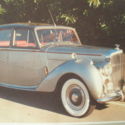1954 Bentley R-Type Saloon
- Price:
- Location: Chandler, Arizona, United States
- Condition: Used
- Make: Bentley
- Model: Other
- SubModel: Saloon
- Type: Sedan
- Trim: Two-Tone Paint
- Year: 1954
- Mileage: 73,000
- VIN: B269YA
- Color: Black and Silver
- Engine size: 6-CYL 4556 cc
- Number of cylinders: 6
- Fuel: Gasoline
- Transmission: GM four-speed hydramatic
- Drive type: Right Hand
- Interior color: Dove Fabric
- Vehicle Title: Clear
1954 Bentley Other Saloon Description
In 1952, entley boosted the size of its engine to 4,566 cc in the so-called “big bore, mall boot” models. The company also rectified the “small boot” criticism with “R” Type chassis, hose wheelbase remained 10 feet but whose overall length was extended eight inches at the rear, o create a useful trunk space.
GM’s four-speed Hydra-matic automatic transmission became available in 1953, nd was soon standardized.
The new welded box chassis was strengthened by cruciform bracing. Standard accessories included a radio, heater, itted tools, eather upholstery, nd a sunroof.
In all 2,320 R Types would be built during the car’s four years of production.I am the 4th owner bought after previous owner passed away and the car was stored in Arizona for about ten years. The radiator was rebuilt and all weather stripping was replaced. I believe the car was sold to the first American buyer in 1978.
I believe the car to have a rating between #3 (Good) and #4 (Fair) according to the current Hagerty Insurance rating model.
Fair: Vehicles are daily drivers, ith flaws visible to the naked eye. The chrome might have pitting or scratches, he windshield might be chipped. Paintwork is imperfect, nd perhaps the body has a minor dent. Split seams or a cracked dash, here applicable, ight be present. No major parts are missing, ut the wheels could differ from the originals, r other non-stock additions might be present. A #4 vehicle can also be a deteriorated restoration. "Fair" is the one word that describes a #4 vehicle.
Good: Vehicles could possess some, ut not all of the issues of a #4 vehicle, ut they will be balanced by other factors such as a fresh paint job or a new, orrect interior where applicable. #3 vehicles drive and run well, ut might have some incorrect parts. These vehicles are not used for daily transportation but are ready for a long tour without excuses, nd the casual passerby will not find any visual flaws. "Good" is the one word description of a #3 vehicle.
 1954 Bentley R type Sunroof Saloon RHD
1954 Bentley R type Sunroof Saloon RHD
Mileage: 200,000
 1953 Bentley R Type Saloon
1953 Bentley R Type Saloon
Mileage: 38000
 1955 Bentley R Type Mark VII Sports Saloon
1955 Bentley R Type Mark VII Sports Saloon
Mileage: 75,599
 1955 Bentley R-Type Mark II Sports Saloon
1955 Bentley R-Type Mark II Sports Saloon
Mileage: 75,599
 1954 BENTLEY R SALOON CALLED "THE SILENT MAN"
1954 BENTLEY R SALOON CALLED "THE SILENT MAN"
Mileage: 121,768
 1952 Bentley R Type SPORT SALOON, Arctic White
1952 Bentley R Type SPORT SALOON, Arctic White
Mileage: 44,688
 1953 Bentley R Type Steel Sports Saloon 62612 Miles Charcoal Gray Sedan 4566 cc
1953 Bentley R Type Steel Sports Saloon 62612 Miles Charcoal Gray Sedan 4566 cc
Mileage: 62612
 1954 Bentley Type R
1954 Bentley Type R
Mileage: 203000
 1954 Bentley R-type
1954 Bentley R-type
Mileage: 85,000
 1954 Bentley Type R 70k resotration Immaculate
1954 Bentley Type R 70k resotration Immaculate
Mileage: 98,808








